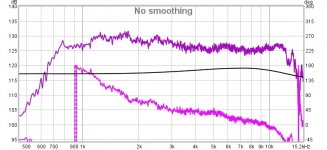Thanks again docali. I considered the LTH142 when I was investigating horns to purchase. I agreed with your assessment, and didn’t consider any of it as faults either; just differences. Also, differences that gave limited information as to how each horn would perform in my home environment. So, I picked one.
I am horn type agnostic. I picked the XT1464 because it will work a little bit lower in frequency than the LTH142, and I was buying a larger diaphragm driver – the Radian951PB.
I’m still looking forward to your research – A Neile radial-like horn could be a beautiful thing.
Sphericalhorns | This is an exclusively private non-commercial blog about spherical horns.
William Neile Horns | Sphericalhorns
I am horn type agnostic. I picked the XT1464 because it will work a little bit lower in frequency than the LTH142, and I was buying a larger diaphragm driver – the Radian951PB.
I’m still looking forward to your research – A Neile radial-like horn could be a beautiful thing.
Sphericalhorns | This is an exclusively private non-commercial blog about spherical horns.
William Neile Horns | Sphericalhorns
Last edited:
Mark, I noticed elsewhere on DIYAudio that you have experience with the ME464 horn. Do you have any thoughts on it's use for home audio?
It seems to me that there are about 3 or 4 commercial horns with 1.4" throats, that are functional for home use; the 18 Sound XT1464, Ciare PR614, FaitalPro LTH142, and possibly the ME464 for a larger horn with lower pattern control. If the first 3 were a little bit larger...
I like the sound of the XT1464. It starts tighter at 60 degrees, and continues to pattern even tighter patterns tighter as frequency rises, than the me464 which stays more constant , but the narrowing still works for me.
The me464 can certainly be used lower though (with the right CD).
I don't know any of the other horns you list, but the RCF hf 950 is a nice sounding 90 deg horn.
Thanks Mark. The sound of the XT1464/951PB combo is very enjoyable. The tight pattern works well for me. I think the tight pattern is a plus.
Still working on crossover iterations. I model in XSim3d. It's not perfect. I use the data from Radian which is based on a different horn mounting. Then, program into one of the amp user presets; QSC PLD 4.3. I can recall different ones quickly and easily to try different setups. Just need to limit PEQ to 5 points.
BTW, was reading more at the me464 thread. Noticed you and others were discussing sub use with the QSC PLD 4.5. I use the PLD 4.5 in AB CD mode, parallel not bridge, to power two SI24mkII separate subs; 4ohm load each; two 2ohm coils in series. More power and volume than needed in any normal home space. I light the -20 LEDs on subbass, LFE, peaks. Amp works fine. More fan noise than the PLD 4.3. A PLD 4.3 in this config would still be more than enough. If I used the subs and amps to the limits, I would need plumbing repairs, have structural damage, and produce 7.0 seismic events in my neighbors home.
Still working on crossover iterations. I model in XSim3d. It's not perfect. I use the data from Radian which is based on a different horn mounting. Then, program into one of the amp user presets; QSC PLD 4.3. I can recall different ones quickly and easily to try different setups. Just need to limit PEQ to 5 points.
BTW, was reading more at the me464 thread. Noticed you and others were discussing sub use with the QSC PLD 4.5. I use the PLD 4.5 in AB CD mode, parallel not bridge, to power two SI24mkII separate subs; 4ohm load each; two 2ohm coils in series. More power and volume than needed in any normal home space. I light the -20 LEDs on subbass, LFE, peaks. Amp works fine. More fan noise than the PLD 4.3. A PLD 4.3 in this config would still be more than enough. If I used the subs and amps to the limits, I would need plumbing repairs, have structural damage, and produce 7.0 seismic events in my neighbors home.
Thanks Mark. The sound of the XT1464/951PB combo is very enjoyable. The tight pattern works well for me. I think the tight pattern is a plus.
Still working on crossover iterations. I model in XSim3d. It's not perfect. I use the data from Radian which is based on a different horn mounting. Then, program into one of the amp user presets; QSC PLD 4.3. I can recall different ones quickly and easily to try different setups. Just need to limit PEQ to 5 points.
BTW, was reading more at the me464 thread. Noticed you and others were discussing sub use with the QSC PLD 4.5. I use the PLD 4.5 in AB CD mode, parallel not bridge, to power two SI24mkII separate subs; 4ohm load each; two 2ohm coils in series. More power and volume than needed in any normal home space. I light the -20 LEDs on subbass, LFE, peaks. Amp works fine. More fan noise than the PLD 4.3. A PLD 4.3 in this config would still be more than enough. If I used the subs and amps to the limits, I would need plumbing repairs, have structural damage, and produce 7.0 seismic events in my neighbors home.
Hi Paul, fun! That's alot of subbage for sure 😀
About double the displacement i'm running indoors with two double 18" PPSL subs using 18n862. I've run more sub inside, but yeah, it really does risk tearing the house and stuff up.
The fan noise on the PLD4.5 is my only complaint with it; good to hear the 4.3 is quieter. I also use AB CD parallel for two 4 ohm loads. Gotta love the channel combining versatility of the PLD series, Huh?
I got a pair of CXD 4.5Q's cheap off ebay, which are the same as the PLD4.5s, but work on the qsys network and allow digital input, monitoring, and control etc. But they have the same damn fans 😡 So i'm currently using a PL380 for indoor subs which is much quieter.
One really cool thing about the 4 channel CXDQ amps is that they also have four mic/line inputs built in. So as long as i can get AC power and an ethernet cable to the amp, I can measure a speaker out in the field from inside my house.
And can tune a 4-way speaker via qsys, each section individually, while using up to 4 measurement mics all simply plugged into the amp! I love it for that!
Sorry for going on about amps in a horn thread, but don't meet many DIYers using PLDs....🙂
Outline Formula Stack.Cabinet name?
It's an Italian company, known for their advanced 'Newton' loudspeaker processing.
sorry i didn't read through the thread ( 25 pages is a lot ) but if somebody knows where to get the 30" SEOS with 2" throat in US please let me know ...
As the waveguide widens the Higher Order Modes (HOM) modes move down in frequency before they "cut-in" (a term that means below that frequency they do not exist and above they do.) At 30 degrees all the HOM are basically out of band, at 45 degrees they are just moving in-band with the first mode at about 7 kHz for a 1" disk (the throat.) By 90 degrees all of the modes are in band and contribute almost equally to the radiation and the sum of all these modes will yield the exact same polar response as the baffled disk.
If you are mathematically inclined you can see this type of solution in JASA by one of my advisors Gerald Lauchle where he used OS coordinates to solve the unbaffled disk problem exactly. In the unbaffled case only even modes contribute, but in the baffled case only the odd contribute (this has to do with the slopes of the modes at 90 degrees. Even modes have a finite slope, while odd modes have a zero slope.) The exact same thing occurs and can be seen in the polar modes for a sphere where the modes are simple sums of sines and cosines, so it is much easier to see.
PS. I could have the even and odd backwards, but the point remains the same either way.
Attachments
HelloThat's why some Japanese added an throat extension to the 2380A.
The effects are visible in the shaded part of the response curve below.
In the second plot, EQ-ed response shown compared to the raw response (below).
With DSP the response could be improved.
The 2380A isn't a bad horn, provided it's implemented properly.
Can you direct us to the discussion itself, regarding these throat extensions? I have 2450J missing their snouts, and 2380A flares and have to build adapters for the CD's.
I have P-Audio 1.5>2" adapters coming that I will have to modify, and they have an included angle of about 15 degrees which I understand to be an intermediate point between the 2450J with no throat, and the 2380A throat.
cheers
dwf
As it appears (it took me way too long time to dig up the blog post), those guys actually completely modified the 2380 using wood and filler.
The P-Audio 1.5>2" adapter is the only commonly available adapter that should work. It's more or less identical to the 2450J's snout and the throat section of the old 244.. family.
The P-Audio 1.5>2" adapter is the only commonly available adapter that should work. It's more or less identical to the 2450J's snout and the throat section of the old 244.. family.
I've used the LTH142 for a number of years and prefer this LASE with the JBL 2431 in my room. YMMV
https://www.amazon.com/LASE-10-5-Horn-Constant-Directivity/dp/B07N8ZN58R
https://www.amazon.com/LASE-10-5-Horn-Constant-Directivity/dp/B07N8ZN58R
The Lease Horn, a rather good looking clone of the B&C ME 90 (available in Europe for €75) offers controlled directivity and wider coverage at the expense of loading.
In combination with the JBL 2431H, it should be usable from 800-1000 Hz.
Scholl, do you have measurement data of the Lease Horn + 2431 H?
Lease ME 90:

B&C ME 90:

In combination with the JBL 2431H, it should be usable from 800-1000 Hz.
Scholl, do you have measurement data of the Lease Horn + 2431 H?
Lease ME 90:
B&C ME 90:
Last edited:
Yes, I do. And they look pretty good. This one has EQ it would be about 10db down at 10K without EQ. Note that the breakup above 10K is downward where some 1.5" drivers are upward.The Lease Horn, a rather good looking clone of the B&C ME 90 (available in Europe for €75) offers controlled directivity and wider coverage at the expense of loading.
In combination with the JBL 2431H, it should be usable from 800-1000 Hz.
Scholl, do you have measurement data of the Lease Horn + 2431 H?
Lease ME 90:
View attachment 1091462
B&C ME 90:
View attachment 1091461
Attachments
It certainly looks better than I expected. Well-behaved and enough extension not to need a tweeter.
I assume this was outside, given the level?
I assume this was outside, given the level?
Last edited:
Another CD horn, with a relatively smooth slot. No pinching, just a constriction in the horizontal plane like the18Sound, B&C and RCF horns.
Overall, it looks suspiciously like the HF950, albeit without the vanes and with an 'open slot', i.e. the (1" instead of 1.4") throat is fully exposed.
It appears to be tiny, but it isn't > 30 x 30 cm mouth and 22.5 cm length, so cut-off should be < 500 Hz, making it usable from about 700-800 Hz.

Overall, it looks suspiciously like the HF950, albeit without the vanes and with an 'open slot', i.e. the (1" instead of 1.4") throat is fully exposed.
It appears to be tiny, but it isn't > 30 x 30 cm mouth and 22.5 cm length, so cut-off should be < 500 Hz, making it usable from about 700-800 Hz.
Last edited:
There are these 2" horns I found on ZXPC's website -
www.zxpc.us/product-p/231420420855.htm
www.zxpc.us/product-p/331676072699.htm
Both are without diffraction slots and appear to be expo profiles, good down to around 400 hz. They should work well higher up without an added dedicated HF driver.
There's also this CD horn with an odd diffraction slot. Could be good with the correct driver.
www.zxpc.us/product-p/332247699208.htm
www.zxpc.us/product-p/231420420855.htm
www.zxpc.us/product-p/331676072699.htm
Both are without diffraction slots and appear to be expo profiles, good down to around 400 hz. They should work well higher up without an added dedicated HF driver.
There's also this CD horn with an odd diffraction slot. Could be good with the correct driver.
www.zxpc.us/product-p/332247699208.htm
The first 2 are well known examples. The long throw horn is actually a Selenium HL4750 clone...

...which is an updated JBL 2386. The actual dispersion is 40° x 20° instead of 90° x 40°.
Some years ago I referred to the diffraction horn, which is most likely a modified clone of an older PA horn.
Many horns from China are clones, but variants of existing models are also produced, as well as unique horns unknown in the West.
...which is an updated JBL 2386. The actual dispersion is 40° x 20° instead of 90° x 40°.
Some years ago I referred to the diffraction horn, which is most likely a modified clone of an older PA horn.
Many horns from China are clones, but variants of existing models are also produced, as well as unique horns unknown in the West.
We will have two pairs of our horn we can sell in a few months. It will be one time opportunity as we don't plan to sell these separately. Dimensions of horn is: 110 (w) x 80 (h) x 55 cm (d). Directivity approximately 80x50°. Exceptional constant directivity. Works with Radian 951 with 1.4" exit only.
One pair with simple black paint and some aesthetic deviations.
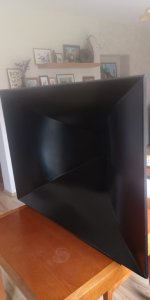
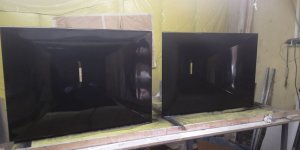
And one pair with walnut veneer on the inside.
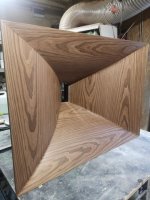
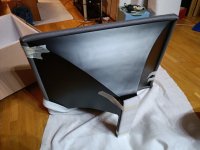
PM me if anyone are interested. Take note that they are not cheap like many PA horns and shipping cost might be high.
One pair with simple black paint and some aesthetic deviations.


And one pair with walnut veneer on the inside.


PM me if anyone are interested. Take note that they are not cheap like many PA horns and shipping cost might be high.
- Home
- Loudspeakers
- Multi-Way
- 1.4" or 2" throat large constant directivity horns you can actually buy!
